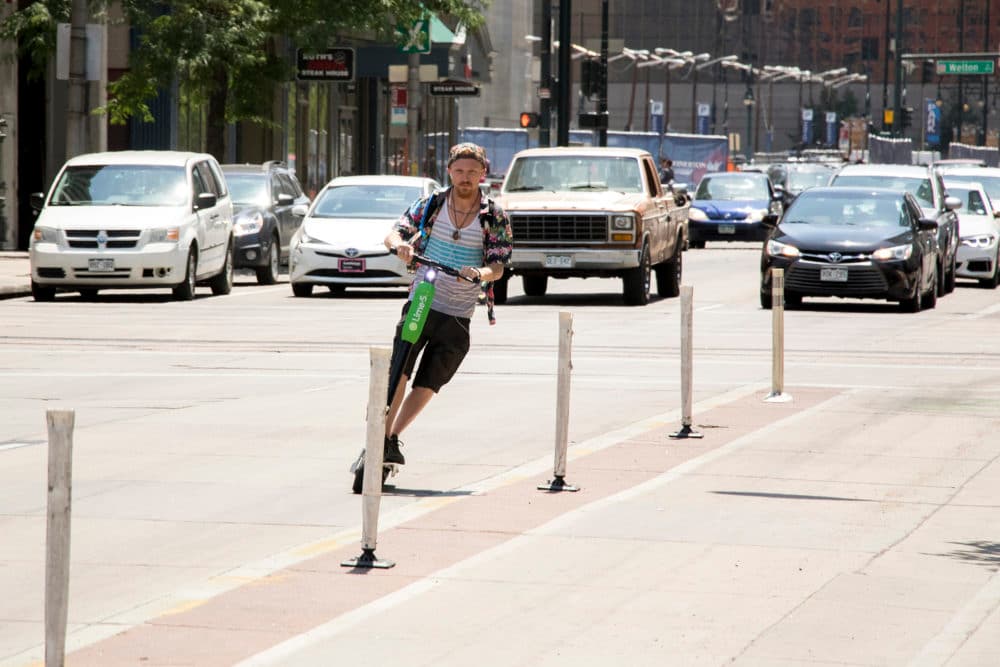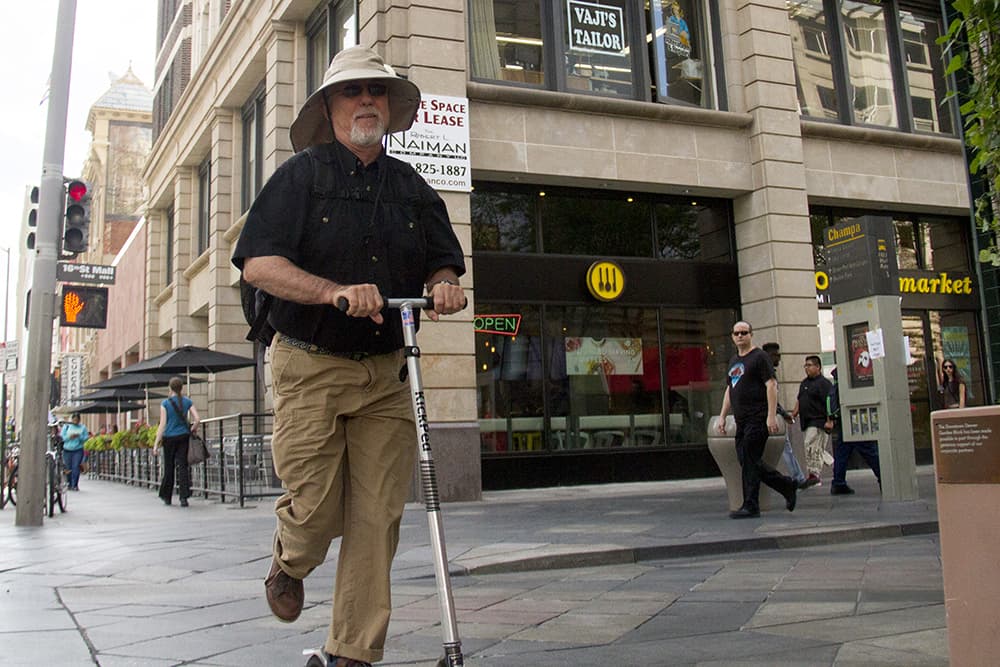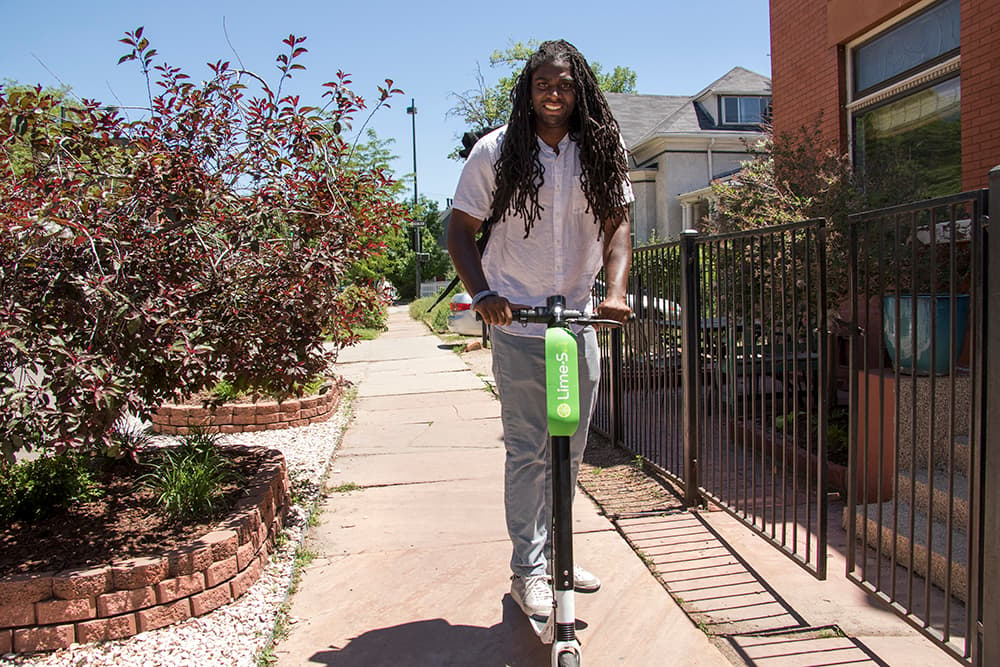In the Denver transportation ecosystem, electric scooter companies are a relatively new addition. The corporate fleets dropped scooters in Denver in May of 2018, and when they arrived, scooting was a lawless, Wild West activity. Whatever rules existed, few riders knew and even fewer followed.
Yet despite the chaos they brought to the streets and sidewalks, there's a lot to be said for scooters. They're eco-friendlier than cars. They take up less space and they don't cause as many parking issues. For bar-hoppers, concert-goers, diners and others looking to avoid parking headaches and hoping to zip through various parts of central Denver, scooting is an ideal fix.
Denverite readers wrote in pleading for clarification on the rules and complaining about irresponsible riders endangering pedestrians.
So why do so many people hate scooters so much?
From the beginning, scooter riders played chicken with pedestrians. And they crashed and crashed and crashed on potholes, filling emergency rooms with lacerated, bone-broken patients. Cars swerved to miss them as they blew through red lights, and bikers were pushed to the curb as scooters were allowed into bike lanes.
Anybody who rolls, walks or drives regularly in Denver has likely dodged -- and even collided with -- out-of-control scooters. People say it's exhausting doing so and makes public space feel less safe.
"Please stress to riders of bikes/scooters to use Bike Lanes, not our downtown sidewalks," wrote Billy Lodo. "I am a senior downtown walker. Sidewalks r not safe!"
"Safety of Cherry Creek Trail for pedestrians is compromised by motorized bikes, scooters and hoverboards that go up to 30mph," wrote Hilary Downes. "Please address."

Since scooters came to Denver, lawmakers have established some rules. The hope is that we can all coexist more-or-less happily. But rules are only as good as the people who follow them.
Denver City Council has passed a string of scooter ordinances over the years to help riders know what is -- and isn't -- okay to do. The rules are all part of the City's Code of Ordinances, which governs everything from landscaping and zoning to human rights.
The part of the law about scooters is covered under Transportation and Motor Vehicles. That includes rules for bikers, drivers and even horse-drawn carriages.
While the Code of Ordinances is widely available, it's rarely read. People are more likely to follow the laws of common sense than the actual law.
But when it comes scooters, common sense isn't so common and there isn't consensus on what's right and wrong. So boning up on official policy before stepping onto the deck is a good idea.
Per law, scooters are treated like any other vehicle and given the same rights. Riders have to follow traffic signs, from red lights to stop and yield signs, and stick to the speed limit -- even on bike trails.
There is one exception to when a rider can ignore stop signs: When an officer of the law says it's okay. An example of that: If you're leaving a ballgame, a police officer directing traffic supersedes whatever a traffic light says. If a light is red and a cop says go, you'd better go.
Scooters aren't given special permissions to do U-turns and other turns when signs say otherwise. If they want to do something other vehicles aren't allowed to do, they have to pull over, get off and walk, following whatever rules pedestrians are required to obey.
Here's what you can't have on a scooter.
Have you ever seen those goofball groups of friends riding two or three to a scooter? Or parents with a kid? That is not allowed. Only one person per scooter, please.
People carrying packages or other objects have to be able to keep at least one hand on the handlebars. We're not sure how someone could keep their balance on a scooter without holding on, but if you're that coordinated, it's an impressive skill that you, unfortunately, cannot share in Denver.

Here's how scooter riders have to interact with pedestrians.
Pedestrians have the right of way -- always. Period. No exceptions. If you hit a pedestrian with your scooter, it's on you.
That means if you're on the sidewalk, you have to let walkers walk and wheelchair users roll. It's not their job to get out of your way.
If you're in traffic and pedestrians are crossing the road, you have to let them do so without zipping into them.
If you see people who are walking, running or rolling, give them all the space they need to do their thing. It's their prerogative. You've gotta wait.
Here's how to ride on bike lanes and roadways.
You can't ride more than two abreast. Have three friends? One has to lead or follow. In a bike lane, generally, only one scooter will fit, but the rule does not apply here.
If you're riding on the road or a bike lane -- which is where scooters belong -- stick as far to the right as you can safely. Don't get doored. If you need to take the lane to stay safe, do. But if you can, stay right and let other vehicles pass you.
Follow speed limits and keep your speed under control based on the surrounding traffic.
There is a big exception to rules of where and how fast scooters can go: City, state and federal employees, in uniform, can break these rules when doing their duties. Police operating both marked and unmarked official police vehicles can do the same.

Here's how to park a scooter.
Scooters can be parked at any angle against a curb or at the side of the road where parking is allowed. And they can be parked side by side, assuming they don't block the movement of traffic.
Scooters can park on the sidewalk -- but not if they're going to get in the way of wheelchairs and walkers. In short: Don't park in the middle of the sidewalk.
So what's the deal with riding a scooter on the sidewalk?
Generally, scooters should stay off both public and private sidewalks.
There are a few exceptions. You can ride on a sidewalk if it's part of a designated bike route and if you're parking or just getting going, before riding onto the street.
When scooters are on sidewalks they must go less than 6 miles per hour, and yes, give the right of way to pedestrians.
Uniformed city, state and federal employees are allowed to ride on sidewalks, so if you see a crew of cops zipping by, don't try to make a citizen's arrest. They're well within their rights.

Light it up!
No, you can't get high and ride (though plenty do). But you should light up your scooter, per law.
Every scooter on the roads from dawn to dusk needs to be equipped with a front white-light lamp that can be seen 500 feet ahead, a rear reflector visible 600 feet away under the beams of headlights and reflective materials on both sides visible from 600 feet away. If the scooter doesn't have side-reflective material, the light must be visible from both sides.
No, you can't ride everywhere!
The city's traffic engineer has the right to ban scooters from certain roadways and post signs at will. Those include the 16th Street Mall, where riders frequently buck the rules, despite it being the only no-scooter zone codified into city law.
Guess who's allowed to ride where others may not: Law enforcement on the job.

More rules may be coming.
The Department of Public Works has the right to create new scooter rules, including those targeting electric scooter companies, which can be cited for violations and fined.
Those companies can also be fined for failing to obtain permits to operate.
Common sense -- even though it's uncommon -- goes a long way. And not all circumstances are covered by law.
If you're scooting around town and are confronted by other street and sidewalk users, keep your cool. Fights just aren't worth it. If you make a mistake and break the rules, fess up and apologize. No need to defend your jerky behavior. If you don't know what you're doing wear a helmet and pads and practice, practice, practice.
Mostly, have fun, be kind and respect your fellow traffic users. If you're not sure what the rule is, try to do the cautious thing. And eventually, people might just start loving scooter riders on the streets... maybe.
Ride safe, people.












